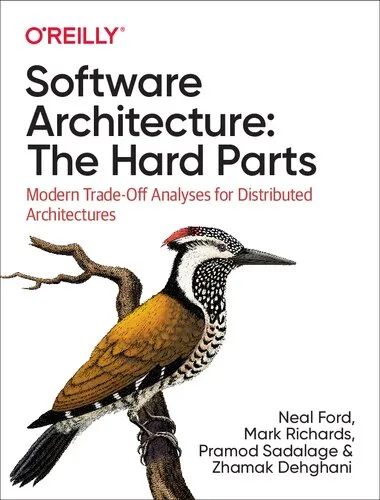Software Architecture: The Hard Parts: Modern Trade-Off Analyses for Distributed Architectures
4.7
بر اساس نظر کاربران

شما میتونید سوالاتتون در باره کتاب رو از هوش مصنوعیش بعد از ورود بپرسید
هر دانلود یا پرسش از هوش مصنوعی 2 امتیاز لازم دارد، برای بدست آوردن امتیاز رایگان، به صفحه ی راهنمای امتیازات سر بزنید و یک سری کار ارزشمند انجام بدینمعرفی کتاب "Software Architecture: The Hard Parts"
کتاب "Software Architecture: The Hard Parts" نوشته Neal Ford, Mark Richards, Pramod Sadalage و Zhamak Dehghani یکی از منابع بینظیر در حوزه معماری نرمافزار مدرن است. این کتاب یک راهنمای جامع برای تحلیل پیچیدگیها و انجام تصمیمگیریهای استراتژیک در معماریهای توزیعشده ارائه میدهد. در دنیای امروز، که نرمافزارها بیشتر به سمت سیستمهای توزیعشده و Microservices پیش میروند، چالشهای مربوط به حفظ یکپارچگی، قابلیت توسعه و مقیاسپذیری بیش از پیش اهمیت پیدا کرده است. این کتاب برای تمام معماران نرمافزار و توسعهدهندگانی نوشته شده که با سوالات و تصمیمگیریهای دشوار در این حوزه مواجه هستند.
خلاصهای از کتاب
کتاب "Software Architecture: The Hard Parts" به بررسی جنبههای چالشبرانگیز معماری نرمافزار میپردازد. نویسندگان بهطور خاص روی مفاهیمی مانند Domain-Driven Design (DDD)، تقسیم سیستمهای بزرگ به bounded contextها، Event-Driven Architectures، Data Mesh، و چالشهای ناشی از Consistency در سیستمهای توزیعشده تمرکز کردهاند. آنها با استفاده از الگوها و نمودارهای قابلفهم، راهکارهایی برای تصمیمگیریهای سخت و مدیریت trade-offها ارائه میدهند. انعطافپذیری (Flexibility)، کارایی (Performance)، و مقیاسپذیری (Scalability)، محوریترین نکات مطرح در این کتاب هستند.
این کتاب بهجای ارائه یک دستورالعمل گامبهگام، به بررسی نحوه تحلیل مسائل و فهمیدن پیامدهای تصمیمات مختلف میپردازد. به عبارت دیگر، به جای اینکه تنها روی پاسخها تمرکز کند، تلاش میکند سوالهای درست بپرسد و کمک کند که خوانندگان به یک فهم عمیقتر از محیطهای پیچیدهای که در آن کار میکنند، دست یابند.
نکات کلیدی
- استفاده از Domain-Driven Design برای کاهش پیچیدگیهای معماری.
- تعادل بین Data Ownership و Decentralized Data Architecture با استفاده از الگوی Data Mesh.
- تحلیل چالشهای Consistency و تصمیمگیریهای مربوط به CAP theorem در سیستمهای توزیعشده.
- بررسی چگونگی اجرای Change Management در معماریهای بزرگ و پیچیده.
- ارائه استراتژیهایی برای کشف trade-offها و مدیریت تصمیمهای سخت معماری.
جملات معروف از کتاب
"A good software architecture is less about making perfect decisions and more about knowing how to fix the bad ones."
"There is no silver bullet in architecture—it’s all about trade-offs."
"Distributed systems are inherently complex; the job of an architect is to manage that complexity."
چرا این کتاب اهمیت دارد؟
معماری نرمافزار هنر و علمی است که بخش عمدهای از مسئولیتهای موفقیت یا شکست پروژههای نرمافزاری را به دوش میکشد. با پیشرفت سریع تکنولوژیها و ظهور الگوهایی همچون Cloud-Native و Microservices، چالشهای معماری نیز پیچیدهتر شدهاند. کتاب "Software Architecture: The Hard Parts" به معماران نرمافزار کمک میکند تا محیطهای نامطمئن و پیچیده را بهتر درک کنند و تصمیمات آگاهانهتری اتخاذ نمایند.
این کتاب نهتنها به شما کمک میکند چالشهای روزمره معماری را حل کنید، بلکه به شما یک رویکرد استراتژیک برای مدیریت این سیستمها میآموزد. تمرکز این کتاب بر ارائه ابزارهای فکری سبکبال و مؤثری است که میتواند معماری نرمافزار را به سطح کاملاً جدیدی ارتقا دهد. اگر بهدنبال رشد حرفهای در این زمینه هستید، مطالعه این کتاب ضروری است.
Introduction to Software Architecture: The Hard Parts
Modern software systems demand architectures that are robust, scalable, and maintainable. Yet, with distributed systems becoming the norm, architects face increasingly complex choices and trade-offs that test their technical expertise and decision-making abilities. Software Architecture: The Hard Parts: Modern Trade-Off Analyses for Distributed Architectures serves as a beacon for tackling these challenges, offering practical insights into the intricate world of distributed software architecture.
Detailed Summary of the Book
The book dives deep into the core challenges of software architecture, especially focusing on distributed architectures — where complexity often hides beneath layers of abstraction. Authored by seasoned experts Neal Ford, Mark Richards, Pramod Sadalage, and Zhamak Dehghani, the content strikes a balance between theoretical grounding and real-world application.
One of the key highlights of the text is its emphasis on trade-offs. Instead of providing a "one-size-fits-all" solution, the authors explore multiple architectural paradigms, guiding architects on how to evaluate the pros and cons of each approach based on the context. The book covers critical topics such as data consistency in distributed systems, microservices choreography versus orchestration, API design, component coupling, and team autonomy.
Through practical examples and frameworks, the text arms architects with the tools to navigate difficult design decisions. Additionally, it delves into organizational dynamics and governance, areas often overlooked but essential for successful architectural outcomes in distributed systems.
Key Takeaways
The book delivers actionable insights for software architects, offering lessons that resonate across different domains and industries.
- Understand the impact of distribution on architectural components such as data stores, APIs, and workflows.
- Learn to perform trade-off analyses for distributed architectures by considering consistency, scalability, and maintainability.
- Explore advanced topics like microservices communication models and how they influence system behavior.
- Discover techniques for managing organizational constraints and aligning architecture with business goals.
- Master event-driven architecture patterns and their applicability in modern distributed systems.
Famous Quotes from the Book
Wisdom and inspiration abound throughout the book, and some of its most memorable quotes serve as guiding principles for architects:
"Software architecture is the art of balancing trade-offs. With distributed systems, every decision has consequences you must understand and factor into your design."
"The hardest part of architecture isn’t knowing the right answers but asking the right questions to expose the trade-offs inherent in every possible solution."
"Collaboration between teams is both an architectural and organizational problem. Solving one without addressing the other rarely leads to success."
Why This Book Matters
In the rapidly evolving landscape of software development, architects face new challenges that require not only technical expertise but also the ability to navigate uncertainty and make informed trade-offs. Software Architecture: The Hard Parts illuminates and demystifies these challenges, delivering a comprehensive toolkit for tackling distributed architectures.
This book is invaluable because it equips architects with the skills to evaluate architectural decisions against business and technical requirements systematically. Unlike many architectural texts, it doesn’t shy away from the "hard parts." It tackles them head-on, offering insights and strategies that are directly applicable to real-world scenarios.
It’s not just a book for software architects—it’s a book for engineers, team leads, and anyone involved in designing systems intended to last. With its focus on trade-off analysis, team dynamics, and modern architectural patterns, it bridges the gap between theory and practice, fostering a deeper understanding of distributed systems architecture.
دانلود رایگان مستقیم
You Can Download this book after Login
دسترسی به کتابها از طریق پلتفرمهای قانونی و کتابخانههای عمومی نه تنها از حقوق نویسندگان و ناشران حمایت میکند، بلکه به پایداری فرهنگ کتابخوانی نیز کمک میرساند. پیش از دانلود، لحظهای به بررسی این گزینهها فکر کنید.
این کتاب رو در پلتفرم های دیگه ببینید
WorldCat به شما کمک میکنه تا کتاب ها رو در کتابخانه های سراسر دنیا پیدا کنید
امتیازها، نظرات تخصصی و صحبت ها درباره کتاب را در Goodreads ببینید
کتابهای کمیاب یا دست دوم را در AbeBooks پیدا کنید و بخرید
1103
بازدید4.7
امتیاز50
نظر98%
رضایتنظرات:
4.7
بر اساس 0 نظر کاربران
"کیفیت چاپ عالی بود، خیلی راضیام"


